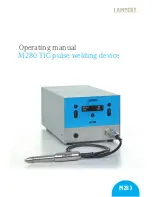
•
Place a magnet rod in the same axis of the magnetic switch (see Figure 9)
•
Use a small piece of wet cotton and touch together the two gold plated sea sensor (see
picture).
•
Place a voltmeter with negative tip to ground an positive tip to TP4 (R18 & C6 net, see
Figure 2) and check the voltage move from 0 to 3 Volts in 5 seconds.
•
Then check the Drain pin of Q4 ; shall be move to 0 Volts (close condition) when the
complete RC delay time is occur.
4.8 Oscillator circuit
The oscillator circuit is a Butler oscillator; the residual capacitances of the crystal X1 is tuned at
121.5 Mhz using L5. The voltage across X1 is pumped via C11 and C15 as voltage elevator, then
the second inductor L3 is tuned with C11//C15 at the same crystal frequency. C8 is used only as
DC coupler. The Butler oscillator is made using a cascode amplifier U6.
4.9 Verify the power amplifier circuit
To verify the functionality of the PA stage, shall be connected a coaxial cable with a BNC
terminal to the TP3 (see figure 2), than connect the BNC connector to a spectrum analyzer and
set the instrument as:
•
Frequency (central) = 121.5 MHZ
•
Span = 5 Mhz
•
Resolution Bandwidth = 50 Khz
•
Video Bandwidth = 3 Mhz
•
Top level = 0 dBm
•
Scale = 10 dB / div.
Press the
TEST
button and check the level emission (as Figure 7); the peak level shall be almost
-40 dBm and the modulation index (level variation from top to bottom level ) shall be almost 30
dB range.
Change the spectrum analyzer top level (or connect a dummy load attenuator in series to the
W400 MOB and the instrument) to:
•
Top level = +25 dBm
And :
•
Place a magnet rod in the same axis of the magnetic switch(see Figure 9)
Press the
TEST
button and check the level emission (as Figure 6); the peak level shall be almost
+17 dBm and the modulation index (level variation from top to bottom level ) shall be almost 30
16
Summary of Contents for W400 MOB
Page 1: ...W400 Rescue MeTM Service Manual Ed 1 00 0 4 2010 ...
Page 2: ...2 ...
Page 4: ...4 ...
Page 6: ...6 ...
Page 8: ...8 ...
Page 10: ...10 ...
Page 18: ...18 ...
Page 20: ...20 ...
Page 21: ...21 Figure 1 Schematic diagram ...
Page 22: ...22 ...
Page 23: ...23 Figure 2 PCB Layout top view TP1 TP2 TP3 TP4 ...
Page 24: ...24 ...
Page 28: ...28 ...
Page 30: ...30 ...
Page 31: ...31 Figure 3 Mechanical layout exploded ...
Page 32: ...32 ...
Page 34: ...34 ...
Page 36: ...36 Figure 5 Beeper tone ...
Page 37: ...37 Figure 6 Flash light strobe signal ...
Page 38: ...38 Figure 7 RF emission in TEST mode ...
Page 39: ...39 Figure 8 RF emission in ARMED mode ...
Page 40: ...40 Figure 9 Magnete position for ARMED activation ...
Page 41: ...41 ...
Page 42: ...42 ...
















































